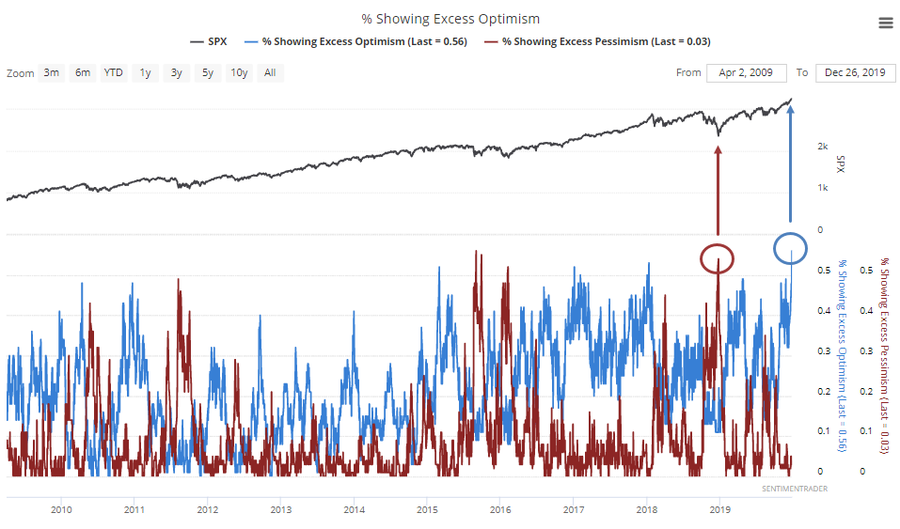These are the recent series on “investing rules” . The purpose of this is to remind investors of the importance of having an investment discipline to protect investment capital when market volatility eventually comes.
The volatility seems to be a thing of the past, particularly given the amount of exuberance currently embedded in the markets.
The biggest problems facing investors over the long-term are falling prey to the various psychological behaviors which impede our investing success. From herding to recency bias, to the “gambler’s fallacy,” these behaviors create critical errors in our portfolio management process, which ultimately leads to the destruction of our investment capital.
The major problem is the loss of “time” to achieve your investment goals. When a major correction occurs in the financial markets, which occur quite frequently, getting back to even is NOT the real problem. While capital can be recovered following a destructive event, the time to reach your investment goals is permanently lost.
The problem is that most mainstream commentators continue to suggest that “you can not manage” your money. If you sell, then you are going to “miss out” on some level of the bull market advance. The problem is they fail to tell you what happens when you lose a large chunk of your capital by chasing the bull market to its inevitable conclusion.
While investing money is easy, it is the management of the inherent “risks” that are critical to your long-term success. This is why every great investor in history is defined by the methods which dictate both the “buy”, but most importantly, “the sell” process.
The difference between a successful long term investor, and an unsuccessful one, comes down to following very simple rules. Yes, I said simple rules, and they are; but they are incredibly difficult to follow in the midst of a bull market. Why? Because of the simple fact that they require you to do the exact OPPOSITE of what your basic human emotions tell you to do:
- Buy stuff when it is being liquidated by everyone else, and;
- Sell stuff when it is going to the moon.
The 7 Impossible Trading Rules To Follow:
Here are the rules – they are not unique or new. They are time tested, and successful investor, approved. If you follow them you succeed – if you don’t, you won’t.
1) Sell Losers Short: Let Winners Run:
It seems like a simple thing to do, but when it comes down to it the average investor sells their winners and keeps their losers hoping they will come back to even.
2) Buy Cheap And Sell Expensive:
You haggle, negotiate, and shop extensively for the best deals on cars and flat-screen televisions. However, you will pay any price for a stock because someone on TV told you too. Insist on making investments when you are getting a “good deal” on it. If it isn’t – it isn’t, don’t try and come up with an excuse to justify overpaying for an investment. In the long run, overpaying will end in misery.
3) This Time Is Never Different:
As much as our emotions, and psychological makeup, want to always hope for the best; this time is never different than the past. History may not repeat exactly, but it often rhymes extremely well.
4) Be Patient:
As with item number 2; there is never a rush to make an investment, and there is NOTHING WRONG with sitting on cash until a good deal, a real bargain, comes along. Being patient is not only a virtue, it is a good way to keep yourself out of trouble.
5) Turn Off The Television:
Any good investment is NEVER dictated by day to day movements of the market, which are nothing more than noise. If you have done your homework, made a good investment at a good price, and have confirmed your analysis to be correct; then the day to day market actions will have little, if any, bearing on the longer-term success of your investment. The only thing you achieve by watching the television is increasing your blood pressure.
6) Risk Is Not Equal To Your Return:
Taking RISK in an investment, or strategy, is not equivalent to how much money you will make. It only equates to the permanent loss of capital which will be incurred when you are wrong. Invest conservatively, and grow your money over time with the LEAST amount of risk possible.
7) Go Against The Herd:
The populous is generally “right” in the middle of a move up in the markets, but they are seldom correct at major turning points. When everyone agrees on the direction of the market due to any given set of reasons, generally something else happens. However, this also cedes to points 2) and 4); in order to buy something cheap or sell something at the best price, you are generally buying when everyone is selling, and selling when everyone else is buying.
These are the rules. They are simple and impossible to follow for most. However, if you can incorporate them you will succeed in your investment goals over the long run. You most likely WILL NOT outperform the markets on the way up, but you will not lose as much on the way down. This is important because it is much easier to replace a lost opportunity in investing. It is impossible to replace lost “time.”
As an investor, it is simply your job to step away from your “emotions” for a moment, and look objectively at the market around you. Is it currently dominated by “greed” or “fear?” Your long-term returns will depend greatly not only on how you answer that question, but how you manage the inherent risk.
“The investor’s chief problem – and even his worst enemy – is likely to be himself.” – Benjamin Graham

No comments:
Post a Comment
Note: Only a member of this blog may post a comment.